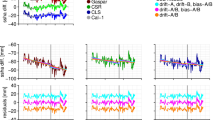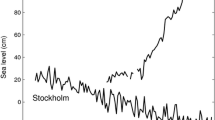Abstract
Over the past three decades, radar altimetry has made a significant contribution to marine gravity field modeling. To improve the accuracy and resolution, we propose a new twin-satellite altimetry. Such a system has several advantages. Among others, it provides (i) twice the number of samples per time epoch, and (ii) information about the cross-track surface gradient with high accuracy because most of the environmental and tidal errors will be common to the simultaneous measurements and therefore cancel out when computing the cross-track gradient computation. We describe a rigorous procedure for the deduction of the sea surface gradient at each altimeter observation point (i.e., not only at the crossovers), from the twin-satellite altimetry system. The precision of the gradient will be slightly affected by orbit errors, instrument drift, and inaccuracies in the geophysical corrections to be applied. We also demonstrate that a 1 mGal accuracy and 1 min resolution marine altimetry gravity field can be obtained if certain conditions are met. To achieve the expected goal, we recommend an orbital configuration, phasing two satellites in 4-s time delay such that the Earth rotation creates a natural baseline between the two satellites, and a 18 kHz SAR altimeter.




Similar content being viewed by others
References
Andersen OB, Knudsen P (1998) Global marine gravity field from the ERS-1 and GEOSAT geodetic mission altimetry. J Geophys Res 103:8129–8137. doi:10.1029/97JC02198
Andersen OB, Knudsen P (2009) The DNSC08 mean sea surface and mean dynamic topography. J Geophys Res 114:C11. doi:10.1029/2008JC005179
Andersen OB (2010) The DTU10 Gravity field and Mean sea surface. Second international symposium of the gravity field of the Earth (IGFS2), Fairbanks, Alaska
Bernard A, Munschy M, Rotsteina Y, Sauter D (2005) Refined spreading history at the Southwest Indian Ridge for the last 96 Ma, with the aid of satellite gravity data. Geophys J Int 162(3):765–778
Carl Wagner (1991) A program of geosat exact repeat mission. J Astronaut Sci 39(3):313–326
Chelton DB, Reis JC, Haines BJ, Fu LL, Callahan PS (2001) Satellite altimetry. In: Fu LL, Cazenave A (eds) Satellite altimetry and earth sciences. Academic, San Diego, pp 1–131
Douglas BC, McAdoo DC, Cheney RE (1987) Oceanographic and geophysical applications of satellite altimetry. Rev Geophys 25(5):875–880. doi:10.1029/RG025i005p00875
Fairhead JD, Green CM, Odegard ME (2001) Satellite-derived gravity having an impact on marine exploration. Leading Edge 20:873–876
Fu L-L, Cazenave A (2001) Satellite altimetry and earth sciences: a handbook of techniques and applications. Academic Press, San Diego
Giles K, Winham D, Galin N et al. (2012) Precise estimates of ocean surface parameters from Cryosat, OSTST2012, Venice, Italy, http://www.aviso.oceanobs.com/fileadmin/documents/OSTST/2012/oral/02_friday_28/05_instr_processing_IIb/02_IP2B_Giles.pdf
Haxby WF, Karner GD, Labrecque JL, Weissel JK (1983) Digital images of combined oceanic and continental data sets and their use in tectonic studies. EOS Trans AGU 64(52):995–1004
Hwang C, Parsons B (1996) An optimal procedure for deriving marine gravity from multi-satellite altimetry. J Geophys Int 125:705–719. doi:10.1111/j.1365-246X.1996.tb06018.x
Hwang C (1997) Analysis of some systematic errors affecting altimeter derived sea surface gradient with application to geoid determination over Taiwan. J Geod 71(2):113–130
Maus S, Green CM, Fairhead JD (1998) Improved ocean-geoid resolution from retracked ERS-1 satellite altimeter waveforms. Geophys J Int 134(1):243–253. doi:10.1046/j.1365-246x.1998.00552.x
Olgiati A, Balmino G, Sarrailh M et al (1995) Gravity anomalies from satellite altimetry: comparison between computation via geoid heights and via deflections of the vertical. Manuscr Geod 105:252–260
Pavlis NK, Holmes SA, Kenyon SC, Factor JK (2012) The development and evaluation of the Earth Gravitational Model 2008 (EGM2008). J Geophys Res 117:B4. doi:10.1029/2011JB008916
Raney RK, Porter DL, Monaldo FM (2002) Bistatic WITTEX: an innovative constellation of radar altimeter satellites, proceedings of the international geoscience and remote sensing symposium IGARSS02. IEEE, Toronto
Raney RK, Porter DL (2001) WITTEX: An innovative three-satellite radar altimeter concept. IEEE Trans Geosci Remote Sens 39(11):2387–2391
Sandwell DT (1992) Antarctic marine gravity field from high-density satellite altimetry. Geophys J Int 109:437–448
Sandwelll DT, Garcia E, Soofi K et al (2013) Towards 1-mGal accuracy in global marine gravity from Cryosat-2 Envisat, and Jason-1. The Leading Edge, August, pp 892–899
Sandwell DT, Smith WHF (1997) Marine gravity anomaly from Geosat and ERS-1 satellite altimetry, J Geophys Res 102:10,039–10,054. doi:10.1029/96JB03223
Sandwell DT, Smith WHF (2005) Retracking ERS-1 altimeter waveforms for optimal gravity field recovery. Geophys J Int 163:79–89. doi:10.1111/j.1365-246X.2005.02724.x
Sandwell DT, Smith WHF (2009) Global marine gravity from retracked Geosat and ERS-1 altimetry: ridge segmentation versus spreading rate. J Geophys Res 114:B01411. doi:10.1029/2008JB006008
Vignudelli S, Kostianoy AG, Cipollini P, Benvensite J (2011) Coastal Altimetry. Springer, Berlin. doi:10.1007/978-3-642-12796-0
Wessel P, Watts AB (1988) On the accuracy of marine gravity measurements, J Geophys Res 93(B1):393–413. doi:10.1029/JB093iB01p00393
Acknowledgments
This research was supported by the National Natural Science Foundation of China (Grant: 41274050), Public Science and Technology Research Funds Projects of Ocean of China (201405027-2) and Science and Technology Project of National Administration of Surveying, Mapping and Geo-information of China (K201101). We thank the editor and reviewers for suggesting improvements to the manuscript.
Author information
Authors and Affiliations
Corresponding author
Rights and permissions
About this article
Cite this article
Bao, L., Xu, H. & Li, Z. Towards a 1 mGal accuracy and 1 min resolution altimetry gravity field. J Geod 87, 961–969 (2013). https://doi.org/10.1007/s00190-013-0660-1
Received:
Accepted:
Published:
Issue Date:
DOI: https://doi.org/10.1007/s00190-013-0660-1




